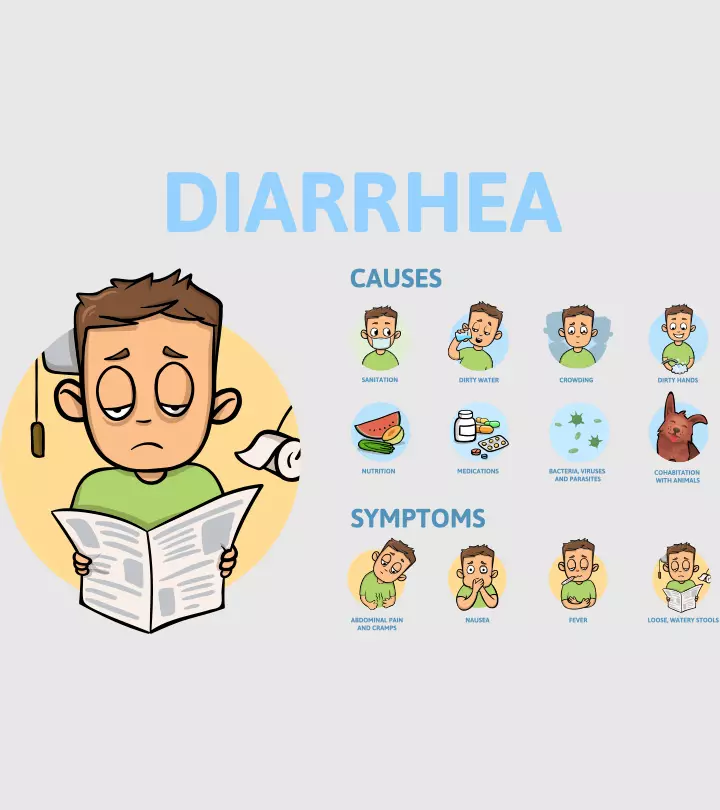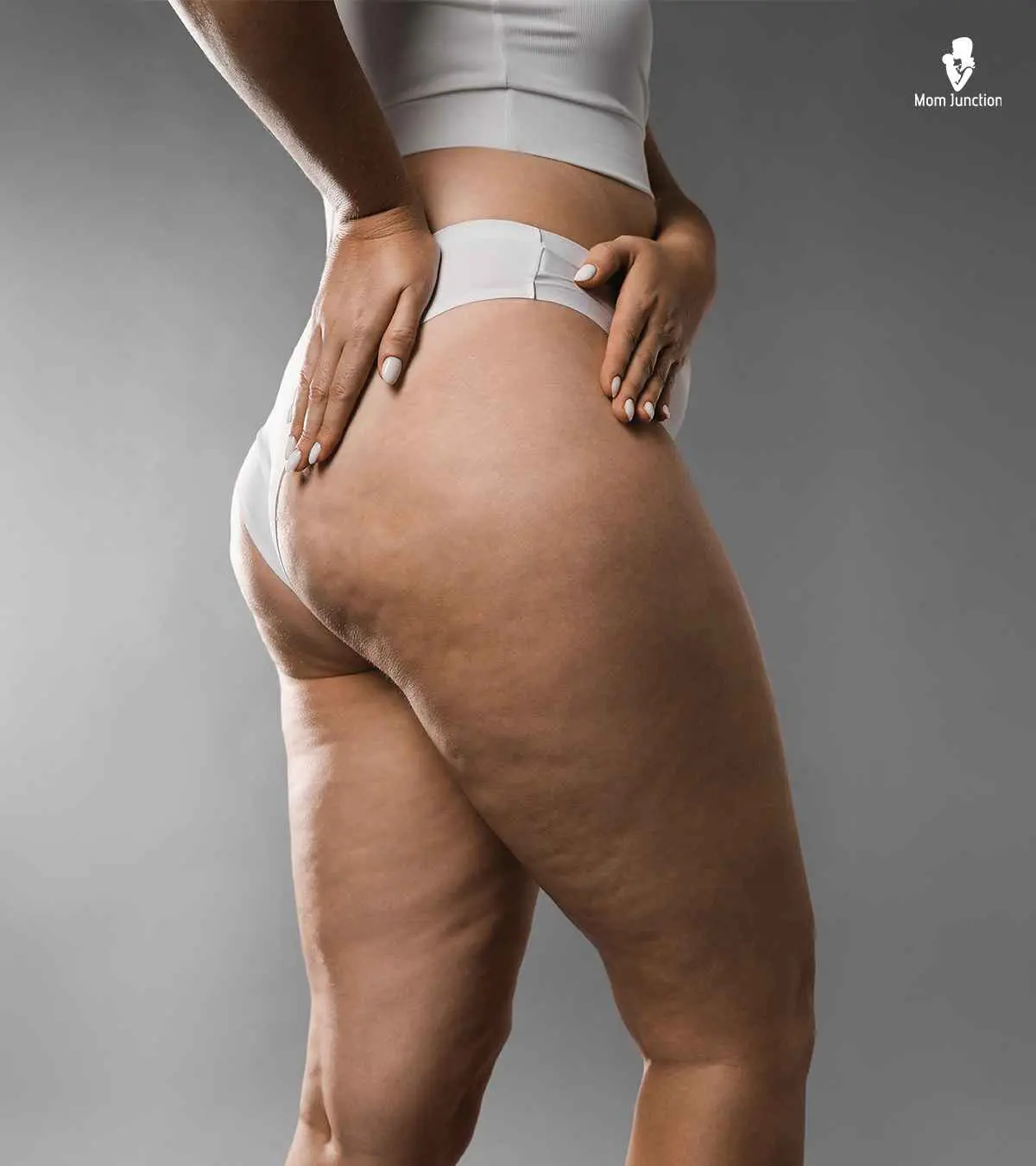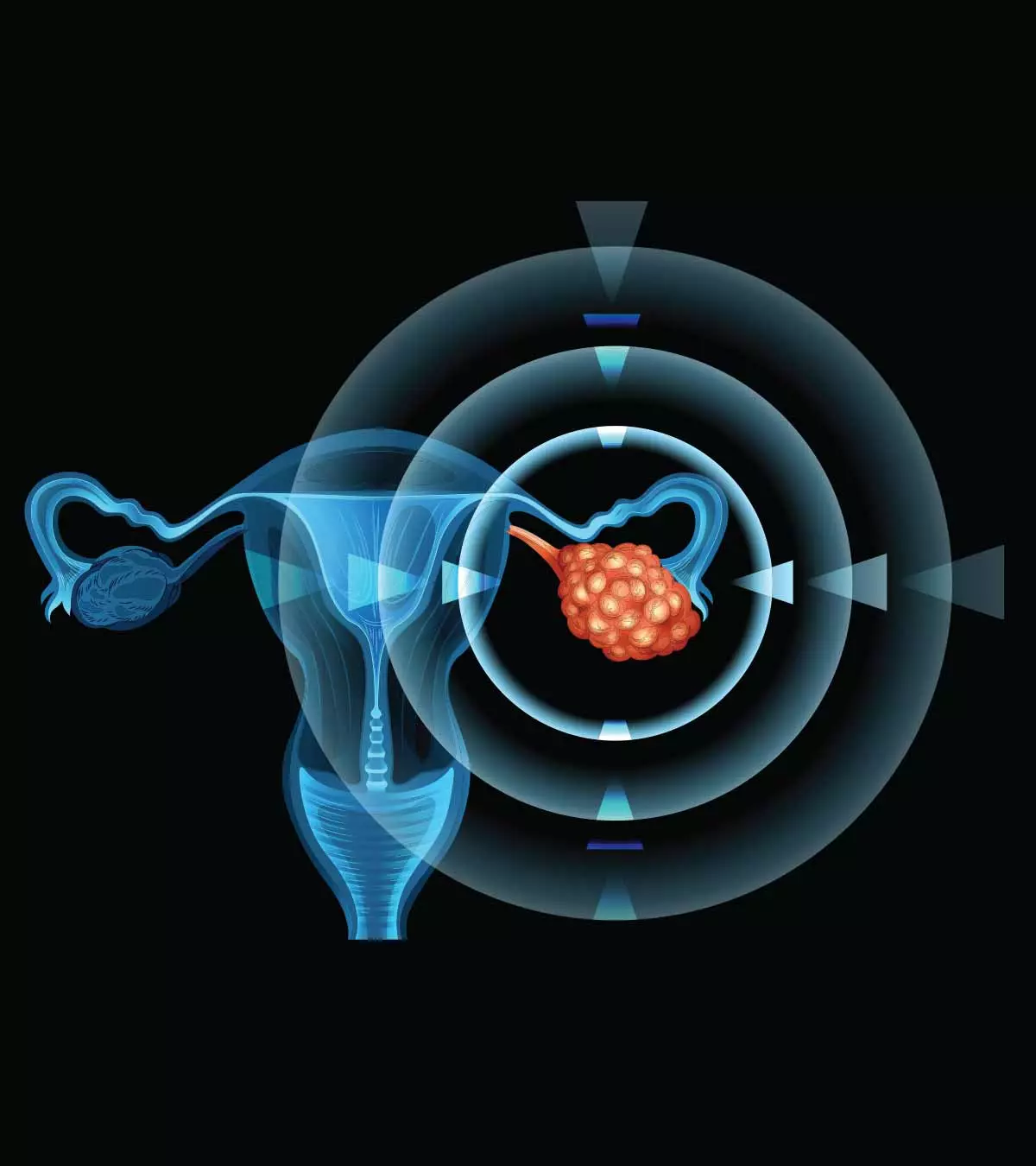
Image: Midjourney/ MomJunction Design Team
Acrochordons or skin tags are soft and small skin bumps often seen on skin folds of the armpits, groin, buttocks, or eyelids (1). Self-treatment for skin tags on children is not recommended due to the risk of skin infections. Skin tags are harmless, painless, and non-cancerous (benign growths), but some children may not be comfortable with them. Usually, these tiny skin lesions can range from 1mm to 2mm in size. If there is an aesthetic concern or your child feels any discomfort, you may connect with a specialist in pediatric dermatology to seek help for skin tag removal. It’s important for parents to distinguish skin tags from other skin conditions. Read on to learn what skin tags are, how they differ from warts and moles, and when to see a doctor for further advice.

Key Pointers
- Skin tags, also known as acrochordons, are tiny and soft growths that often appear on skin folds.
- Skin tags are typically benign, painless, and non-cancerous.
- Children may develop skin tags due to various reasons such as rubbing and friction in skin folds, hereditary conditions, obesity, health problems like type 2 diabetes and high blood pressure, HPV infection, and abnormalities in body functioning.
- Skin tags are typically harmless and painless, and can be identified by their skin-colored or pink appearance.
- A physical examination can confirm the presence of skin tags. There are several treatment options available, including freezing, cutting, burning, ligation, and laser therapy.
Differences Between Skin Tags, Warts, And Moles
Skin tags, warts, and moles are the common types of skin growths, each with unique characteristics. Skin tags are small, benign skin growths composed of blood vessels, fat, and sometimes fibrous tissue. They are usually the same as your skin color or may look like an extended skin growth. Occasionally, they might look darker (2) (3).
Moles can be pink, tan, or brown and may be raised or flat. They are often found on sun-exposed areas of the skin and can be round or oval. It is crucial to monitor moles for changes in shape, size, or texture, as they can sometimes develop into skin cancer (melanoma) (2) (3).
Warts are benign skin growths commonly found on hands and feet. They are similar in color to the skin but have a rough texture and are caused by specific strains of the human papillomavirus (HPV). Warts are contagious and can spread through direct or indirect contact (2) (3) (4) (5).
Causes Of Skin Tags In Children

Skin tags are a collection of blood vessels and collageniA structural protein of the body that helps build the connective tissue, skin, bones, and tendons and provides flexibility fibers surrounded by a skin layer (thin epidermis). The causes of skin tags are not entirely known, but the following conditions and situations seem to increase their occurrence.
- Chafing and friction in the skin folds: Some parts of the body with skin folds, like neck, groin, eyelids, and armpits, are susceptible to skin tags (4).
- Genetic disorders: Although rare, conditions such as tuberous sclerosisiA rare genetic condition that leads to the growth of non-cancerous tumors in the brain and various other areas of the body and Birt-Hogg-Dube syndromeirare genetic condition that leads to benign skin growths, lung cysts, and a heightened risk of developing kidney cancer increase the possibility of skin tags (4).
- Obesity: Obese or overweight children could be at a higher risk because of friction of the skin. A study of 55 children under 18 with skin tags found that nearly half were obese, 20% were overweight, and the average age of diagnosis was 10. The skin tags were most commonly found in the underarm area, and about 5.5% of the children had metabolic syndrome, a condition linked to obesity (6).
- Chronic problems: Health issues, such as type 2 diabetes and high blood pressure, seem to increase the risk of developing skin tags (7).
- HPV infection: Contracting the human papillomavirus (HPV) infection may increase the possibility of developing skin tags (8).
- Defects in body functions: Sometimes, skin tags may be related to defects in body functions, such as impaired lipid metabolism and abnormalities in liver enzyme (9).
- Children who have diabetes.
 Did you know?
Did you know?Are Skin Tags Contagious?
Skin tags are benign and not contagious because they are generally not caused by microorganisms. They primarily develop due to rubbing and friction from skin folds. Your child might experience mild pain, irritation, or, rarely, infection due to the constant friction of skin tags with clothing, jewelry, or other objects (2). Some studies suggest an association of skin tags with HPV, which is also the causative agent of warts. Both warts and skin tags are benign, but unlike warts, which are highly contagious, skin tags are non-contagious (4) (10).
Symptoms Of Skin Tags In Children
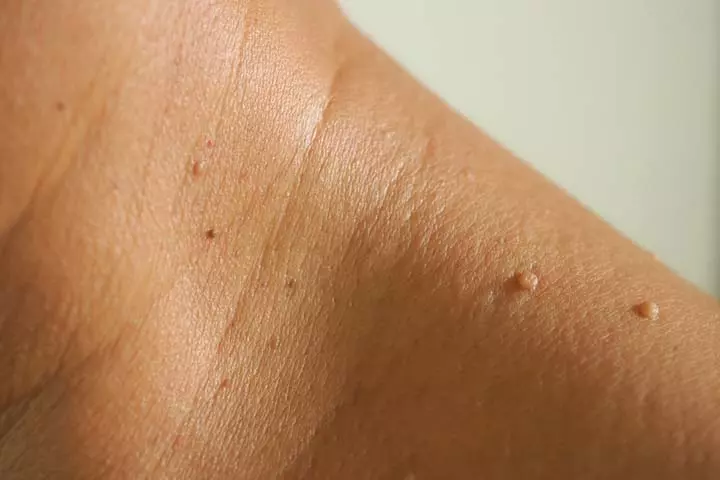
Skin tags are neither harmful nor painful by themselves. Any pain in a skin tag is often due to friction or when the skin tag twists, causing a blood vessel to clot.
 Quick fact
Quick factYou can usually identify skin tags by their skin-colored or pinkish bump-like appearance. The other signs and symptoms are (3).
- In children, tags commonly appear on the face, stomach, chest, groin, arms, and legs.
- The skin tag could be a bump or have a long stalk to hang from the skin.
- Some tags could be darker than the surrounding skin and appear as tiny dark bumps.
- Skin tags often appear in clusters. If you spot a tag, look for the skin around it for more of them.
 Quick fact
Quick factHow Are Skin Tags Diagnosed?
There are no significant tests required to diagnose skin tags in children. A physical examination is usually enough for a doctor to diagnose skin tags. They may check the size and location of the tag to determine its cause. If the doctor suspects the bump to be some other skin condition, then a biopsy may be performed. Biopsy for skin tags is seldom needed.
Madison Miller, a mother of two, reflects on the medical checks her daughter had when they discovered a skin tag on her ear. She notes, “On her left ear, she (her daughter) has a little skin tag. When I had her, they (doctors) checked her hearing and her kidneys to make sure everything was good. Usually, when there’s a skin tag right there, it could potentially indicate an issue with the kidney or affect hearing (11) (12). Thankfully, she was completely fine, and everything checked out perfectly, thank god (i).”
Are There Home Remedies To Remove Skin Tags In Children?

People apply salicylic acid, apple cider vinegar, tea tree oil, or garlic to the tags every day until the tag falls off, but there is no scientific backup to prove it.
Trying to remove skin tags at home with nail clippers or other tools, or pastes and lotions may result in infection, scarring, or bleeding.
If your child wants the skin tags to be removed, you may consult the doctor to know about the treatment options.
Nurse practitioner Shawnda Dorantes says, “For skin tag removal in kids, safe options include cryotherapy, cauterization, or minor surgical excision—all best performed by a healthcare provider. At-home removal methods are not recommended, as they can lead to irritation, infection, or scarring.”
Treatments To Remove Skin Tags In Children
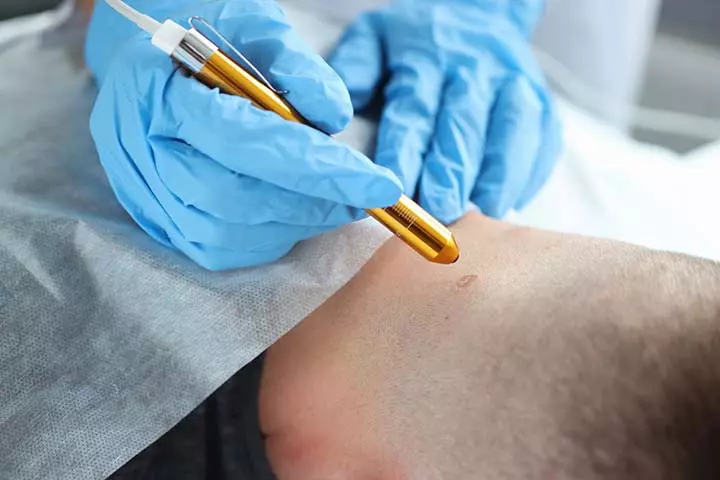
Based on the skin tag’s size or form, child’s age, and health condition, the doctor may suggest any of the following treatment options.
- Freezing: This technique is also called cryotherapy or liquid nitrogen method. The doctor uses a spray or swab to apply liquid nitrogen on the skin tag. The frozen skin tag is then removed with a pair of medical tweezers. Sometimes, the frozen tag comes off in a few days by itself. There might be a small blister after the procedure, but the recovery will be on its own (13) (14).
- Cutting: In some cases, doctors may use clean, sharp scalpel to remove the skin tag from the skin gently. (15) (16).
- Burning: The doctor uses a heated wire to burn the stem of the skin tag. The technique causes minimal bleeding and is unlikely to leave scars or marks (17). But the doctor will decide if this treatment method can be used for the child.
- Ligation: It involves tying a surgical thread to the stalk of a skin tag and thus cutting off its blood supply. It causes the skin tag to fall on its own. This procedure may be slow and may only be suitable if the child has a few skin tags.
- Laser therapy: It is very simple and painless. However, it is quite expensive.
 Quick tip
Quick tipMost skin tags are painless and harmless, but children may feel uncomfortable. Although they usually do not need any treatment, in rare cases, your child’s doctor may suggest one, especially if the tags become bothersome. If your child has had a tag removed, consider these tips to help them recover faster.
How To Care For Your Child’s Skin Post-Treatment?
After the skin tag removal, the doctor will suggest an aftercare regime. It usually includes (16):
- Keeping the site clean and dry by washing it with clean water once or twice a day, followed by gentle patting.
- Applying petroleum jelly or an antibiotic ointment, as advised by the doctor, over the wound and covering it with a bandage.
Skin tag removal is typically low-risk, and the site usually heals on its own. Ensure the wounds do not reopen and attend follow-up visits as advised by the doctor. If your child has redness, fever, pain, bleeding, or pus at the site, consult the doctor promptly.
Is It Possible To Prevent The Spread Of Skin Tags?

It is not possible to prevent skin tags. However, children can be taught measures to avoid the factors that increase the risk of developing skin tags.
- Dress the child in clothes that minimize the friction between skin folds.
- Maintain good hygiene to avoid HPV and related issues like verrucae or plantar warts. Washing hands and not sharing towels is also essential. There are vaccines available for a few types of HPV. Speak to a doctor about immunizing your child and other family members if there is a high risk of contracting the infection.
- Proper management of congenital conditions may help in reducing the risk of skin tags.
Are There Any Creams To Remove Skin Tags?
You will find a few over-the-counter (OTC) creams on the market that claim to lessen or eliminate skin tags. However, these products are not evaluated or approved by the FDA. The FDA advises against their use due to potential side effects.
Most of these creams have high concentrations of salicylic acidiA chemical substance commonly used in topical treatments for acne and other skin conditions and other harmful ingredients, which may cause long-term injury to the surrounding skin, such as scarring or discoloration (18). Therefore, avoid removing skin tags at home and instead seek professional advice for safe and effective management of your child’s skin tags.
Frequently Asked Questions
1. Does vitamin E oil remove skin tags in children?
Vitamin E is beneficial for the skin since it helps retain moisture and prevents cell damage (19). However, insufficient research has been conducted to conclude whether it can help remove skin tags in children.
2. When should I worry about skin tags in children?
Skin tags generally do not cause any discomfort and are not a cause for concern. However, you could consider getting them removed if they frequently snag on jewelry and thus cause pain or bleeding (5).
3. Do skin tags grow back bigger?
Dr. Bidisha Sarkar says, “Skin tags tend to stay the same size or shrink over time; some may increase in size if irritated due to friction or regular contact with clothing. If you notice a skin tag growing bigger than before, consult your doctor as soon as possible for further evaluation and treatment.”
4. What steps can parents take to minimize scarring after skin tag removal in children?
Skin tag removal under medical supervision may not leave scars. However, improper skin tag removal methods may lead to scarring (4). There is no single way to minimize scarring. Keeping the scar area clean and moisturized, following the topical treatment recommended by the dermatologist, and protecting the area from the sun are some ways to promote healing and minimizing scarring
5. Should parents be concerned if their child has many skin tags?
Skin tags are generally pain-free and not known to cause any harm. You can even find skin tags in babies and toddlers. However, if too many or a large skin tag is present, they may rub against the clothing, causing friction and discomfort. They may also increase the risk of developing several skin tags nearby (4). Moreover, too many or a large skin tag on the visible area, such as the face, neck, or hands, can make a child conscious of their appearance and hinder their self-perception. They may worry about being judged or teased, affecting their self-esteem and confidence (4).
6. How can parents distinguish between skin tags and other types of skin growths on their child’s skin?
Differentiating between skin tags and other types of skin growths can be difficult for parents. Therefore, if you notice any unusual or concerning skin growths on your child, promptly speak to a pediatric dermatologist. The expert will carefully monitor the skin’s growth and suggest treatment accordingly.
7. What role do hormones play in developing skin tags in children?
According to experts, elevated estrogen and progesterone levels have been linked to an increased risk of developing skin tags in females. Children diagnosed with acromegalyiA condition that arises when the body produces an excessive amount of growth hormone have elevated levels of human growth hormone, which also increases the risk of developing skin tags (4).
8. Are there any dietary or lifestyle changes that can prevent skin tags from developing in children?
No specific dietary or lifestyle changes can prevent the development of skin tags in children. Regular physical exercise, a healthy diet, staying hydrated, practicing good hygiene, and weight management are some healthy habits that generally support a child’s skin health.
9. When should I seek medical attention for skin tags in my child?
You should seek medical attention for your child’s skin tags if they appear suddenly in large numbers, change in size or color, or cause discomfort. Additionally, if the growth looks unusual, has different colors, or shows signs of bleeding or pain, it’s important to have a doctor evaluate it, as it may not be a typical skin tag and could require further examination (20).
Skin tags on kids are seldom severe, usually seen in some regions of the body, and caused due to skin friction, obesity, genetic reasons, and other medical conditions. Though they do not need medical attention, your child may be uncomfortable with them. However, get your child evaluated if you feel the skin tags are growing in size or associated with other skin conditions. Furthermore, you may consult a dermatologist to discover the risks, treatments, and management of skin tags in children. Nevertheless, train your child to maintain good overall hygiene and dress in comfortable clothing to reduce the risk of skin tags.
Infographic: What Disorders Cause Skin Tags In Children?
Skin tags in children can occur due to various reasons. Identifying the disorders linked to skin tags is vital since some reasons require treatment. Go through the infographic to learn about the disorders linked to skin tags in children. Illustration: Momjunction Design Team
Illustration: Skin Tags In Children Causes Remedies And Removal Methods
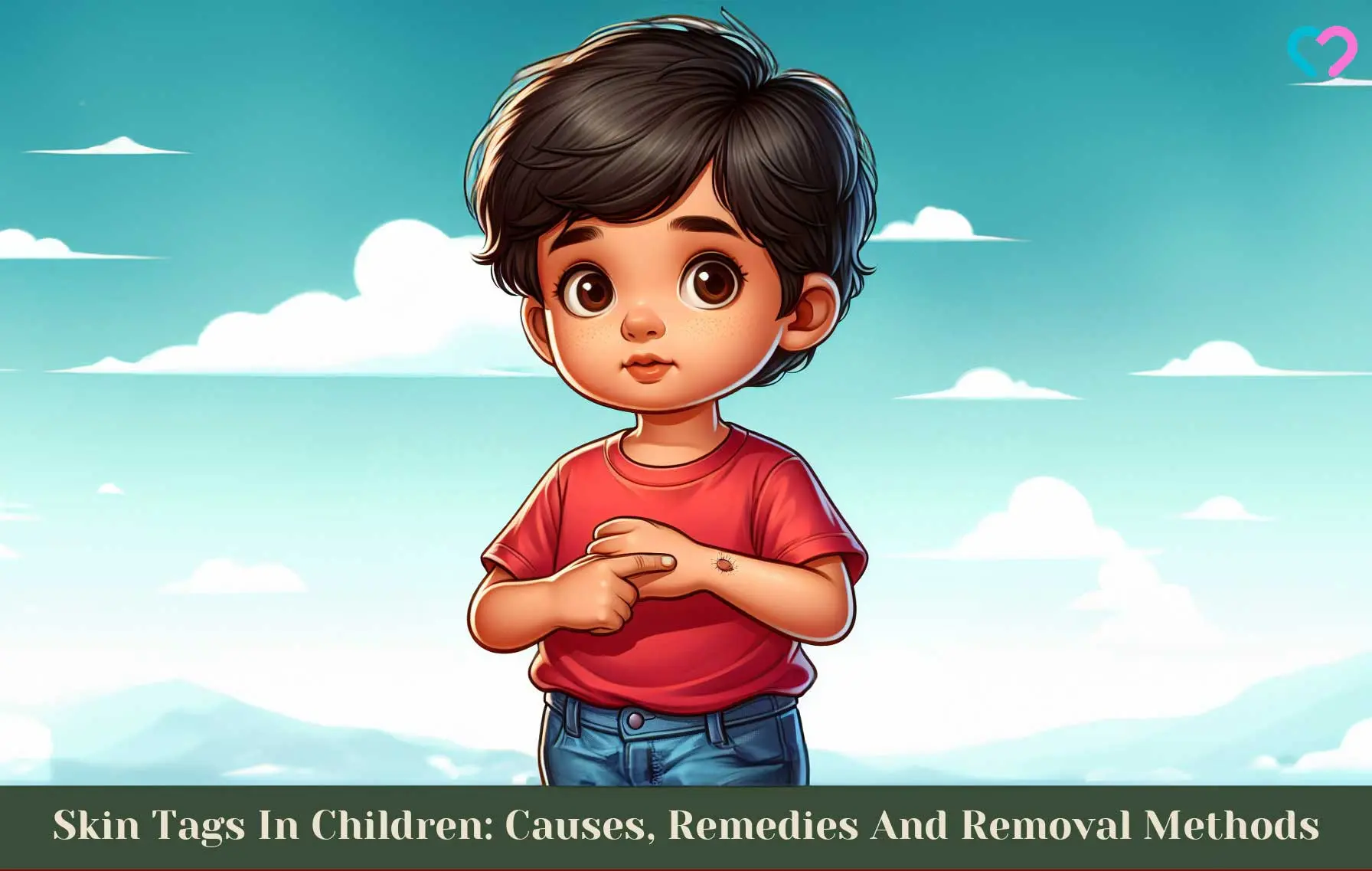
Image: Dall·E/MomJunction Design Team
Learn all about skin tags – what they are, how to treat them, and more! Get the facts and find out how to get rid of them safely.
Personal Experience: Source
MomJunction articles include first-hand experiences to provide you with better insights through real-life narratives. Here are the sources of personal accounts referenced in this article.
i. Baby 1 year old update! | docband, skin tag, & walking update!;https://www.youtube.com/watch?v=HQc1uH9ufMo&feature=youtu.be
References
1. Skin Tags (Acrochordon); Harvard Health Publishing (2019)
2. Skin Tag vs. Mole: How Can You Tell the Difference? Houston Methodist (2025)
3. The Skinny on Skin Tags: 6 Questions and Answers; Penn Medicine (2018)
4. A. Pandey and S. Sonthalia; Skin Tags; National Center for Biotechnology Information (2019)
5. Skin tags; NHS
6. Greene, Rachel K., et al.;The Relationship between Acrochordons, Obesity, and Metabolic Syndrome in the Pediatric Population: A Retrospective Cohort Study; Pediatric Dermatology
7. L. Mitchell; Facts About Skin Tags; University of Utah (2018)
8. A. Oakley; Skin Tag; DermNet NZ
9. A. H. Maluki and A. A. Abdullah; Metabolic Associations with Skin Tags; International Journal of Dermatology and Clinical Research (2015)
10. AM Al Aboud and PK Nigam; Wart; National Center for Biotechnology Information (2025)
11. Ear Tags; Nemours Children’s Health
12. Arora, Rajiv et al.; (2004); Is ultrasonography required to rule out renal malformations in babies with isolated preauricular tags? Archives of Disease in Childhood.
13. Removing Moles and Skin Tags; Kaiser Foundation Health Plan of Washington
14. H. P. Goodheart; Surgical Pearl: A rapid technique for destroying small skin tags and filiform warts; Dermatology Online Journal (2003)
15. Skin Tags (Acrochordons); Cleveland Clinic
16. Skin Tag Removal in Children: Care Instructions; Kaiser Permanente
17. Unsighty Skin Tags? Your Doctor Can Help; Intermountain Healthcare (2018)
18. Products Marketed for Removing Moles and Other Skin Lesions Can Cause Injuries, Scarring; USFDA
19. Vitamin E for Skin: What Does It Do? Cleveland Clinic (2025)
20. Skin tag removal: Optional but effective; Harvard Health Publishing
21. Tamega Ade A et al.; Association between skin tags and insulin resistance; Anais brasileiros de dermatologia (2010)
Community Experiences
Join the conversation and become a part of our nurturing community! Share your stories, experiences, and insights to connect with fellow parents.
Read full bio of Dr. Mubina Agboatwalla

Shawnda Dorantes is a family nurse practitioner with over 11 years of experience in acute care and the founder of Beauty Lounge Medical Spa. Established in 2018, Beauty Lounge is a full-service aesthetic center in San Diego, California. Shawnda triple-majored in Biological Sciences, Women’s Studies, and Nursing from Cal State University San Marcos in 2010 and holds Allergan Master Injector certification. She earned her Master of Science in Nursing in 2021 to become a certified Family Nurse Practitioner (FNP).
Shawnda Dorantes is a family nurse practitioner with over 11 years of experience in acute care and the founder of Beauty Lounge Medical Spa. Established in 2018, Beauty Lounge is a full-service aesthetic center in San Diego, California. Shawnda triple-majored in Biological Sciences, Women’s Studies, and Nursing from Cal State University San Marcos in 2010 and holds Allergan Master Injector certification. She earned her Master of Science in Nursing in 2021 to become a certified Family Nurse Practitioner (FNP).
- Dr. Bidisha Sarkar is a pediatrician with nine years of experience. She did her graduation in Medicine from NRS Medical College, Kolkata and holds specialization in Pediatrics. Dr. Sarkar currently practices at KIMS Hospital in Hyderabad, India.
 Dr. Bidisha Sarkar is a pediatrician with nine years of experience. She did her graduation in Medicine from NRS Medical College, Kolkata and holds specialization in Pediatrics. Dr. Sarkar currently practices at KIMS Hospital in Hyderabad, India.
Dr. Bidisha Sarkar is a pediatrician with nine years of experience. She did her graduation in Medicine from NRS Medical College, Kolkata and holds specialization in Pediatrics. Dr. Sarkar currently practices at KIMS Hospital in Hyderabad, India.
Read full bio of Dr Bisny T. Joseph
Read full bio of Swati Patwal
Read full bio of Anindita Ghatak










